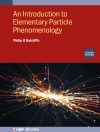Gathering research from physics, mechanical engineering, and statistics in a single resource for the first time, this text presents the background to the model, its theoretical basis, and applications ranging from materials science to earth science.
The authors start by explaining why disorder is important for fracture and then go on to introduce the fiber bundle model, backed by various different applications. Appendices present the necessary mathematical, computational and statistical background required.
The structure of the book allows the reader to skip some material that is too specialized, making this topic accessible to the engineering, mechanics and materials science communities, in addition to providing further reading for graduate students in statistical physics.
Зміст
Preface XIII
1 The Fiber Bundle Model 1
1.1 Rivets Versus Welding 1
1.1.1 What Are Models Good For? 3
1.2 Fracture and Failure: A Short Summary 4
1.3 The Fiber Bundle Model in Statistics 5
1.4 The Fiber Bundle Model in Physics 6
1.5 The Fiber Bundle Model in Materials Science 8
1.6 Structure of the Book 8
2 Average Properties 11
2.1 Equal Load Sharing versus Local Load Sharing 11
2.2 Strain-Controlled versus Force-Controlled Experiments 12
2.3 The Critical Strength 16
2.4 Fiber Mixtures 22
2.5 Non-Hookean Forces 24
2.5.1 Fibers with Random Slacks 24
2.5.2 Elastic–Plastic Model 25
3 Fluctuation Effects 27
3.1 Range of Force Fluctuations 28
3.2 The Maximum Bundle Strength 30
3.3 Avalanches 32
3.3.1 The Burst Distribution 33
3.3.1.1 The Forward Condition 35
3.3.1.2 The Backward Condition 36
3.3.1.3 Total Number and Average Size of Bursts 37
3.3.2 Asymptotic Burst Distribution: 5/2 Law 40
3.3.2.1 Asymptotic Burst Distribution: Nongeneric Cases 42
3.3.3 Inclusive Bursts 45
3.3.4 Forward Bursts 47
3.3.5 Avalanches as Random Walks 49
3.3.5.1 The Exact Random Walk 49
3.3.5.2 Asymptotic Burst Distribution via Random Walks 51
3.3.6 Energy Release 53
3.3.6.1 High-Energy Asymptotics 53
3.3.6.2 Low-Energy Behavior 55
3.3.7 Failure Avalanches for Stepwise Load Increase 57
3.3.7.1 Uniform Threshold Distribution 58
3.3.7.2 General Threshold Distribution 59
4 Local and Intermediate Load Sharing 63
4.1 The Local-Load-Sharing Model 64
4.1.1 Redistribution of Forces 66
4.1.2 Determining the Failure Sequence 67
4.1.3 Bundle Strength 68
4.1.4 Failure of First and Second Fibers 69
4.1.4.1 Other Threshold Distributions 75
4.1.4.2 Localization 76
4.1.5 Hole Size Distribution 78
4.1.5.1 Defining the Hole Size Distribution 78
4.1.5.2 Hole Size Distribution for Equal Load Sharing 79
4.1.5.3 Hole Size Distribution for Local Load Sharing: Localization 80
4.1.6 Estimating the Strength of the Local-Load-Sharing Model 82
4.1.6.1 Lower Bound for the Largest Hole 83
4.1.6.2 Competing Failure Mechanisms 85
4.1.6.3 Uniform Threshold Distribution 86
4.1.7 Force and Elongation Characteristics 88
4.1.8 Burst Distribution 90
4.2 Local Load Sharing in Two and More Dimensions 93
4.2.1 Localization 94
4.2.2 Similarity with the Equal-Load-Sharing Fiber Bundle Model 95
4.2.3 Burst Distribution 99
4.2.4 Upper Critical Dimension 99
4.3 The Soft Membrane Model 101
4.4 Intermediate-Load-Sharing Models 104
4.4.1 The γ-Model 105
4.4.2 The Mixed-Mode Model 106
4.5 Elastic Medium Anchoring 107
4.5.1 Size Equals Stiffness 109
4.5.2 Localization in the Soft Clamp Model 109
4.5.3 Asymptotic Strength 110
4.5.4 Fracture Front Propagation 112
5 Recursive Breaking Dynamics 115
5.1 Recursion and Fixed Points 116
5.2 Recursive Dynamics Near the Critical Point 119
5.2.1 Universality 120
5.2.1.1 General Threshold Distribution 124
5.2.2 Postcritical Relaxation 125
5.2.2.1 Uniform Threshold Distribution 126
5.2.2.2 General Threshold Distribution 129
5.2.3 Precritical Relaxation 131
5.2.3.1 Uniform Threshold Distribution 131
5.2.3.2 General Threshold Distribution 133
5.2.4 Critical Amplitudes 134
6 Predicting Failure 137
6.1 Crossover Phenomena 138
6.1.1 The Avalanche Size Distribution 138
6.1.1.1 Burst Avalanches at Criticality 141
6.1.2 Energy Bursts 142
6.1.3 The Crossover Phenomenon in Other Systems 144
6.1.3.1 Earthquakes 144
6.1.3.2 The Fuse Model 148
6.2 Variation of Average Burst Size 152
6.3 Failure Dynamics Under Force-Controlled Loading 152
6.4 Over-Loaded Situations 155
6.4.1 Breaking Rate of Loaded Fiber Bundles 155
6.4.1.1 Uniform Distribution 155
6.4.1.2 Weibull Distribution 157
6.4.1.3 Large Overload Situation 158
6.4.2 Energy Emission Bursts 159
6.4.2.1 Uniform Distribution 161
6.4.2.2 Weibull Distribution 162
6.4.2.3 Large Overload Situation 164
6.4.3 Energy Burst Pattern 166
7 Fiber Bundle Model in Material Science 169
7.1 Repeated Damage and Work Hardening 170
7.1.1 The Load Curve 171
7.1.2 Repeated Damages 171
7.1.3 Damages Ending in Complete Bundle Failure 174
7.2 Creep Failure 175
7.2.1 A Model for Creep 176
7.2.2 A Second Model for Creep 180
7.2.2.1 Damage Accumulation 180
7.2.2.2 Time Evolution 181
7.2.2.3 Healing 182
7.3 Viscoelastic Creep 183
7.4 Fatigue Failure 186
7.4.1 A Fatigue Experiment 186
7.5 Thermally Induced Failure 188
7.5.1 Failure Time for a Homogeneous Fiber Bundle 188
7.5.2 Failure Time for Low Thermal Noise 189
7.6 Noise-Induced Failure 190
7.7 Crushing: The Pillar Model 194
8 Snow Avalanches and Landslides 197
8.1 Snow Avalanches 197
8.2 Shallow Landslides 199
Appendix A Mathematical Toolbox 203
A.1 Lagrange’s Inversion Theorem 203
A.2 Some Theorems in Combinatorics 204
A.2.1 Basic Selection Theorems 204
A.2.2 A Distribution with Restrictions 205
A.3 Biased Random Walks 206
A.3.1 Probability of No Return 206
A.3.2 Gambler’s Ruin 207
A.4 An Asymmetrical Unbiased Random Walk 209
A.5 Brownian Motion as a Scaled Random Walk 211
Appendix B Statistical Toolbox 213
B.1 Stochastic Variables, Statistical Distributions 213
B.1.1 Change of Variable 213
B.1.1.1 A Useful Interpretation 213
B.1.2 The Characteristic Function 214
B.1.3 The Central Limit Theorem 215
B.2 Order Statistics 216
B.2.1 Ordering the Variables 216
B.2.2 The Average of the mth Ordered Variable 217
B.3 The Joint Probability Distribution 217
B.3.1 Extreme Statistics 218
B.3.2 The Largest Element: The Three Asymptotic Distributions 218
B.3.2.1 The Gumbel Distribution 219
B.3.2.2 The Second and Third Asymptotes 220
B.3.3 The Smallest Element: The Weibull Distribution 221
Appendix C Computational Toolbox 223
C.1 Generating Random Numbers Following a Specified Probability Distribution 223
C.1.1 When the Cumulative Probability May Be Inverted 223
C.1.2 Gaussian Numbers 224
C.1.3 None of the Above 225
C.2 Fourier Acceleration 225
References 229
Index 233
Про автора
Alex Hansen earned his Ph.D. from Cornell University in 1986. He was then Joliot-Curie fellow at the Ecole Normale Supérieure in Paris, followed by postdoctoral positions at the Universities of Cologne and Oslo. In 1992, Hansen became a CNRS scientist at the University of Rennes 1 in France. From 1994, he has been professor of physics at the Norwegian University of Science and Technology in Trondheim, Norway. Hansen is member of the Norwegian Academy of Science and Letters, the Royal Norwegian Society of Science and Letters and the
Norwegian Academy of Technical Sciences. He is Dr. honoris causa at the University of Rennes 1. Hansen chairs at present the Commission on Computational Physics of the International Union of Pure and Applied Physics, where he is also a vice president.
Per Christian Hemmer earned his doctorate from the Norwegian Institute of Technology in 1959. He was then NORDITA fellow in Copenhagen, followed by a postdoctoral position at The Rockefeller Institute, New York. In 1959 he was appointed professor of theoretical physics at the University of Trondheim, now the Norwegian University of Science and Technology. He has been dean of the faculty for general sciences at the university. Hemmer has been secretary of the Commission on Statistical Physics of the International Union of Pure and Applied Physics, as well as a vice president of the union. He is member of the Royal Norwegian Society of Science and Letters, the Norwegian Academy of Science and Letters, and the Norwegian Academy of Technical Sciences.
Srutarshi Pradhan completed his Ph.D. work at Saha Institute of Nuclear Physics, Kolkata, India in 2004 and earned his doctorate from Jadavpur University, Kolkata, India . He was then a postdoctoral fellow at the Norwegian University of Science and Technology for 4 years (2004-2007) with a fellowship from the Norwegian Research Council. In 2008 he was appointed as a research scientist at SINTEF Petroleum Research, Trondheim, Norway. Pradhan has been promoted to senior scientist position at SINTEF Petroleum Research in 2012.












